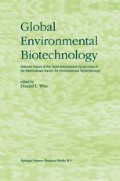Abstract
Microbes have been successfully used to degrade petroleum hydrocarbons for contaminated soil. During biodegradation process, many factors affect the kinetics and the extent of hydrocarbon removal from contaminated soil. These include crude type, soil characteristics, conditions of operation and microbial concentration.
Access this chapter
Tax calculation will be finalised at checkout
Purchases are for personal use only
Preview
Unable to display preview. Download preview PDF.
References
Song H G, Wang X and Bath R 1990 Bioremediation potential of terrestrial fuel spills. Appl. Environ. Microbiol 56, 652-656.
Walker J D, Colwell R R and Petrakis L 1975 Microbial petroleum degradation: application of computerized mass spectrometry. Can. J. Microbiol 21, 1760-1767.
Walker J D, Petrakis L and Cohvell R R 1976 Comparision of the biodegradability of crude and fuel oils. Can. J. Microbiol 22, 598-602.
Westlake D W S, Jobson A, Phillippe R and Cook F D 1974 Biodegradability and crude oil composition. Can. J. Microbiol 20, 915-928.
Huesemann M H and Moore K O 1994 The effects of soil type, crude oil type and loading, oxygen, and commencial bacteria on crude oil bioremediation kinetics as measured by soil respirometry. In Hydrocarbon Bioremediation. pp. 58 - 71. Lewis Publishers, Inc., Chelsea, MI, USA.
Reynolds C M 1993 Field bioremediation rates in a cold region landfarm: spatial variability. In Hydrocarbon Contaminated Soils. pp. 487 - 499. Lewis Publishers, Inc., Chelsea, MI, USA.
McNabb D H, Johnson L R and Guo I 1994 Aggregation of oil-and brine-contaminated soil to enhance bioremediation. In Hydrocarbon Bioremediation. pp. 296 - 302. Lewis Publishers, Inc., Chelsea, MI, USA.
Prince R C, Clark J R, Lindstrous J E et al. 1994 Bioremediation of the Exxon Valdez oil spill: monitoring safety and efficacy. In Hydrocarbon bioremediation. pp. 107 - 124. Lewis Publishers, Inc., Chelsea, MI, USA.
Agnihotri A K and Sharma J S 1992 Review of ecology of microorganisms and biodegradation of oil waste. In Environmental Management in the Petroleum Industry. pp. 195 - 212. Wiley Eastern Ltd., New York.
Author information
Authors and Affiliations
Editor information
Editors and Affiliations
Rights and permissions
Copyright information
© 1997 Springer Science+Business Media Dordrecht
About this chapter
Cite this chapter
Wang, J., Shi, F., Zhao, L. (1997). Treatment of oily soil with microbes in the laboratory. In: Wise, D.L. (eds) Global Environmental Biotechnology. Springer, Dordrecht. https://doi.org/10.1007/978-94-017-1711-3_26
Download citation
DOI: https://doi.org/10.1007/978-94-017-1711-3_26
Publisher Name: Springer, Dordrecht
Print ISBN: 978-90-481-4836-3
Online ISBN: 978-94-017-1711-3
eBook Packages: Springer Book Archive

